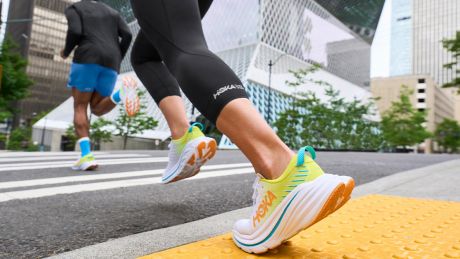Our Verdict
The Bondi X is billed as a carbon shoe for everyone, with a stable and durable design to handle your training and racing alike. However, it falls well short of the performance of other carbon shoes, as well as many training shoes without a plate.
For
- Fairly versatile ride
- Stable for a carbon shoe
Against
- Expensive
- Heavy and not great for fast running
- Carbon plate feels unnecessary
You can trust Coach
Once reserved for elite runners, carbon plate running shoes are increasingly common, and every time I take part in a race I’m struck that they’re worn throughout the field, rather than just by the keenest beans at the front.
Despite this popularity, many runners would still wouldn’t consider this type of shoe “for them”. A major part of that will be the price – many cost over £200 – and part is the lack of durability, with most carbon shoes falling well short of the 700-800km of running you’d expect from a traditional running shoe. They are often soft and unstable too, which can put runners off, and the misconception that super-shoes are the preserve of the fastest does persist, even though evidence suggests that pretty much any runner can benefit.
With an eye on these runners who are curious but unsure about carbon shoes, Hoka has pitched its Bondi X as a carbon shoe that will work for runners of all levels.
The standard Bondi is a popular maximally cushioned shoe whose best quality is how comfortable it is on easy runs. The Bondi X slips a carbon plate into that high stack of cushioning to produce a stiffer, firmer and more versatile ride. The Bondi X is still fairly soft and cushioned, but the extra pop from the plate makes it better suited to faster running too.
I will say, however, that it’s still not a great shoe for fast stuff. On longer runs where I worked through the gears to finish at a steady pace it felt fine, but when running fast from the off, the shoe felt huge and clunky. It’s not exactly heavy, but it’s certainly not light and it feels like there’s a whole load of shoe on your foot.
On easy runs, though, you can get into a nice groove with it, and when rolling along I did find myself running at a faster pace than expected at times. It’s also a more stable ride than most carbon shoes, which otherwise are reserved for fast training sessions. The Bondi X can eat up your base training runs happily enough, but then there are an awful lot of shoes that can do that, and most of those don’t cost £180.
The price of the Bondi X is my main sticking point. It’s the most expensive Hoka carbon shoe, ahead of the Rocket X at £140 and Carbon X 2 at £160. Both of those shoes are more explicitly performance-focused and perhaps the Bondi X will sway runners who are put off by the firmer rides of those shoes – but if the idea is a more accessible carbon shoe for the masses, the price is off-putting.
I’d also question the purpose and performance of the plate here. Maybe there’s a little more stiffness and pop in the shoe because of it, but it doesn’t really translate into a particularly impressive ride – certainly no more so than the Saucony Triumph 19 or New Balance Fresh Foam 1080v11. Both of those are more traditional cushioned shoes that offer a similar mix of comfort and speed to the Bondi X, but without using a carbon plate or costing so much.
Perhaps the biggest question is do you really need or even want a carbon plate for the runs the Bondi X is designed for? I’d argue no. And even if it is a nice thing to have in the shoe, the price is too much for a shoe that doesn’t outperform cheaper, plate-free options.

Nick Harris-Fry is a journalist who has been covering health and fitness since 2015. Nick is an avid runner, covering 70-110km a week, which gives him ample opportunity to test a wide range of running shoes and running gear. He is also the chief tester for fitness trackers and running watches, treadmills and exercise bikes, and workout headphones.

